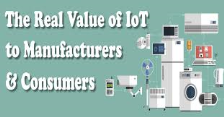The Real Value of IoT is Customer Focused.

The real value of loT to organizations is based on their interaction with customers, and that requires switching from a capital expenditure (CAPEX) to a primarily operating expense (OPEX) business model.
Monetization based on OPEX starts by rethinking the fundamental corporate business model, regardless of industry. In the traditional way of doing business of selling unconnected products, that are focused on features and benefits. In a connected, loT-enabled world, managers will be more focused on the utilization of their products, as this is where they will generate the most revenue.
Products become the strategic assets, changing the strategy from buying to renting.
Let’s look at one of the most traditional old-line industries today: “Vehicle Manufacturing”. Why spend valuable CAPEX resources to design and build cars (on average, it costs more than $2 billion to develop a new vehicle) when you can convert the business model to OPEX and realize recurring revenue by charging for usage? General Motors, a traditional CAPEX-intensive company in this industry, invested $500 million in ride-sharing service Lyft for this reason. In addition, companies can charge subscriptions for infotainment, insurance, maintenance, and more, without ever having to build anything.
For instance, the value of a single loT enabled connection can vary anywhere from $50/month to a few dollars per year. Thus, the monthly average revenue per connection (ARPC) for loT deployments is far lower than the average revenue per user (ARPU) for consumer services-and this can look devastating on a balance sheet.
loT as a profit center needs to be judged separately and on its own merits. The good news is, due to their nature, loT devices are not subject to the same constraints as is a manufactured product. While there is a definite limit to the number of people who can be sold a mobile phone, for example, there is no limit to the number of devices that can be manufactured and deployed when human interaction is not required for use. Even if the ARPC is low, revenue can be high due to the ubiquity of the devices. Thus, loT as a profit center must be judged on scale and margins. The more cost-effective devices deployed, the better the balance sheet looks. And once the infrastructure is in place, there are unlimited opportunities for up-sells, dramatically improving ARPC.
In traditional business models, most departments work independently and are siloed from one another. Only if there is a specific need will interdepartmental cooperation occur, and even then it’s usually with departments that have commonalities, such as sales and marketing.
As with other aspects of corporate infrastructure, loT radically changes this business model, too. Sensors and devices gather so much actionable information on a continual basis that all departments- from engineering to finance- must be intimately involved in the process. Departments can no longer operate in their own isolated worlds, especially if companies intend on operating in the fierce global marketplace.
For example, suppose a new smart service is launched. The data generated is sent to:
* Engineering, so they can refine the service offerings
* Marketing, so they can know what is working and not working from an end-user perspective, plus how to define/refine up-sells
* Finance (including billing), so they can ensure devices are billing correctly and the company is receiving proper payment for services delivered
* Operations, so they can monitor the entire infrastructure closely to guarantee uptime
* And all other departments within the company, so they can operate from the same page on all business processes
Each department now is part of an interconnected ecosystem that demands that information is shared, across all divisions. This enables the enterprise to function as a cohesive unit that can respond to market changes and other challenges with unparalleled knowledge and insight. Initiatives can be implemented immediately- with real-time monitoring-and altered on-the-fly with all stakeholders on board at the same time. The end result is incredible agility and a competitive edge in any business environment.
Category: Uncategorized






